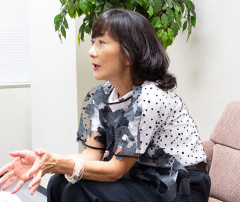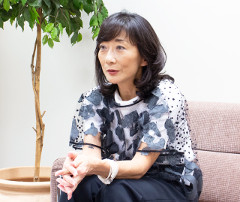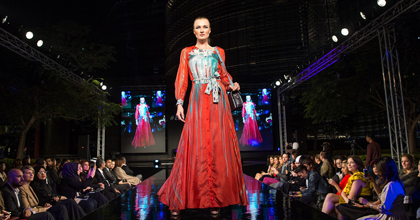Change in the front-row guests invited by brands

Paris Fashion Week is a glamorous show, but its purpose is not the entertainment show by any means. It is a business event, so to speak, for the brands to exhibit and promote their new collections for the next season to industry stakeholders.
Therefore, although the audience are of course invited by the brands, they are not the consuming public. Celebrities on contract with brands may be invited, too, but the guests mainly consist of buyers and journalists.
What is then interesting is that the buyers and journalists from countries with economic strength at the moment, in other words, countries with substantial buying power to buy a lot of those brands’ products, receive preferential treatment, such as being invited by a larger number and being given good seats.
Until in the early 1980s, European and American buyers and journalists occupied the front rows, and the Japanese, even though they could get tickets to the shows, would be seated behind a pillar, or they would be in the standing area where there were no seats.
However, starting in the late 1980s, the Japanese slowly began to receive preferential treatment. The Japanese consumers then were not only buying luxury brand products in the domestic market, but they were also binge-buying them on their trips abroad, benefitting from the high exchange rate of the yen after the Plaza Accord.
In recent years, Chinese customers are replacing Japanese all over the world. In Japan also, the foreign luxury brand shops in locations such as Ginza and Omotesando now have at least one Chinese-speaking sales clerk for attending huge number of Chinese tourists.
As such, looking at the guests seating at the venues of Paris Fashion Week shows us which countries currently carry great economic clout and purchasing power of luxury products.
Another change in the guests in recent years concerns the press. In the past, mainly journalists and fashion editors were invited. The best seat is still given to American Vogue’s Anna Wintour even now.
However, starting in the late 1990s, people called bloggers began to get invited. Their looks do not seem to be remotely relevant to luxury fashion, but as digital influencers (people who influence purchasing decisions of others through online communication tools), their influence to the young generation is so significant that luxury brands can no longer ignore them.
Now, every luxury brand is looking for talent with digital knowledge and skills in its communication department. In addition, people called “street celebrities” are getting invited by the brands, and this is another significant change.
Compared to womenswear, where the trickle-down theory applies and where the trend reflects the influence of celebrities and models to a great extent, in menswear, where the recent direction is trickling up from the street fashion, there are particularly many cases of designers being recruited from the world of street fashion, even at traditional fashion houses.
The taste of the rich has changed with the times, and even the clientele of the top brands has started to show an inclination to favor street-style luxury fashion. As that is the trend, the luxury brands cannot ignore it.
Luxury brands are led by the nose by society’s adaptation to digitalization
Looking at it as we have allowed us to see that Paris Fashion Week, a very glamorous and festival-like event where creative collections and top models gather, and where elaborate staging is produced, is actually the front-line of a fiercely competitive business. Each brand is racking its brains to come up with various ways to survive and sustain itself.
The change in the brand-invited guests, seemingly a form of adaptation to changes in society, is not the only indication. For instance, efforts such as providing live-streaming of runway show have begun. The general public cannot enter the venues, but they can now view live coverage of the shows.
This service may seem to be a form of adaptation to society’s digitization, but in fact, it is one of the countermeasures against the negative impact of digitization.
In the past, the quickest press coverage of Paris Fashion Week came out in newspapers, followed by magazines, and there was a limit to the number of photos and angles of a look that could be published in a single publication. This was to prevent the production of copies before the brands’ products went on sale in the spring and summer of the following year. The photos of the front and back of a look were not to be published at the same time, for example.
However, this has now become a rule in name only. Because the guests lining the front rows are taking photos left and right using their smartphones and sharing them in real time.
Additionally, some industry papers give a seminar about a month after Paris Fashion Week. There, participants can get the documents so-called “trend book”, which contains photos selected from more than 10,000 photos taken by the journalists who covered the event. This book is showing the recapitulated highlight looks, launched by top luxury brands.
The participation fee is not small by any means, but merchandisers in the apparel industry flock to these seminars. And they then take the trends seen in luxury brands and dilute them to remake the affordable designs which the consumers of their local markets can readily wear and market them.
Furthermore, the system in the past was to receive orders from important buyers after Fashion Week, and then launch the production following their ordered quantity of each pieces. But now, there is a move to sell products to consumers immediately after the runway show at the Fashion Week.
Of course, the volume and looks is limited, but brands are trying to adopt a see-now, buy-now scheme, where pieces just seen in the show are available for purchase right away, even at the risk of manufacturing products before professional buyers’ order and even for pieces with uncertain salability.
This is a measure to make sales before consumer enthusiasm cools down, which bubbles up on SNS immediately after the show, the glamorous event. Because if a brand follows the traditional calendar, its products will go on sale at retail stores six months after the show is held, but by then, the fervor on SNS will have faded.
The move has another side to it, which is to serve as a countermeasure to fast fashion. Fast fashion can pick up only the promising features of the top brands’ designs, then quickly retail similar products, with a short lead time (procurement period).
By the time the original brands retail their new pieces six months later, the general consuming public may have seen enough of these designs. Thus, these brands are trying to showcase the radiance of their original designs through live coverage in advance.
Such moves by luxury brands in recent years indicate their attitude of trying to take in digital advancement, because they can no longer ignore it, and how, while trying to counter it, these brands are being led by the nose by fast fashion, which has been on the rise along with that digital advancement.
The appeal of fashion is the presence of the sun, the luxury brands, shining a light on those around them

Last fall, a major online shopping company announced a scheme to create fashion designs using artificial intelligence (AI). Whether this becomes a reality remains to be seen, but in fact, in the area of fashion retail, AI has been introduced aggressively.
One example is a system which recommends the best items to each customer using CRM (customer relationship management).
The labor-intensive task of sorting and organizing more than 10,000 photos of the looks for the aforementioned seminars, which is currently undertaken by humans, will be completed in a flash by AI. Furthermore, in the work to create products based on these looks by diluting their tastes, what is important is the degree of dilution, and companies currently rely on intuition and experience of the product planners to determine them.
With AI, it is possible to feed in not only the customer data, but also other necessary data such economic trends and past fashion trends, and have it calculated the degree of dilution to make marketable products for everyone, as well as for fashion-loving consumers.
But isn’t there something wrong with this narrative? Regardless of whether the act of copying the final designs is carried out by humans or by AI, there are creators at the beginning of all that, who integrate their own philosophy with the brands’ concepts, and create the original works through frantic efforts.
Without their continuous efforts from the past to the present day, fashion would not have come to be.
Recently, how the general public may travel to the moon has become a topic attracting much attention. The moon, which appears particularly enormous in the night sky and shines beautifully, enchants people. However, when you observe it from close quarters, it is a barren and boring sphere full of rocks.
The moon looks pretty because the sun illuminates it. I believe the top brands are the sun, and their radiance shines a light on every corner of the fashion industry and its peripheral industries, and it is making fashion look beautiful to consumers.
The word “fashion” has the power to make people feel happy and to let them dream. I believe that is because humans understand the value of creativity.
In that sense, I personally would like many young creators to have the grit to “head up to the sun,” which is not easy, and not to “go to the moon” with marketable products that have a wearable feel.
When discussing the issue of whether luxury brands can survive while preserving their tradition in these days of accelerated digitization in society, digitalization is said to dull human sensibilities, but that is not always the case. An example: people who post impressive photos on Instagram are experiencing the places with their five senses, and it is because their thoughts and feelings come out in the images that viewers are moved.
Photos, of course, do not offer sound, smell or touch, but if the viewers have experiences with those five senses, the Instagram photos will sharing their memories of such experiences, and that leads to them being moved.
It is the same with fashion, and I believe customers who can share the designer’s five senses through their own memories are able to perceive the unique universe which the brand is expressing.
In that sense, regardless of how our social environment changes, and how they are adapting to it, or being influenced by it, authentic luxury brands have a universal origin. And whether they are going to fade away or continue to shine brightly like the sun perhaps depends on whether the five senses in us that feel their origin fade away or not.
However, looking at the seemingly increasing number of young people who dislike mass-produced fast fashion, and favor vintage clothing and customize their clothes, I feel that may be a needless concern.
* The information contained herein is current as of November 2018.
* The contents of articles on Meiji.net are based on the personal ideas and opinions of the author and do not indicate the official opinion of Meiji University.
Information noted in the articles and videos, such as positions and affiliations, are current at the time of production.

